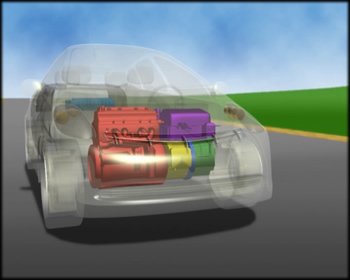Hybrid Driving
Hybrid vehicle driving
Hybrid-electric vehicles (HEVs) combine the benefits of gasoline engines and electric motors and can be configured to obtain different objectives, such as improved fuel economy, increased power, or additional auxiliary power for electronic devices and power tools. Compare Hybrids Side by Side

Basic Hybrid Types - Electric Models - Hybrid Systems - Series-parallel Hybrid - System Components - Driving
Series-parallel hybrid systems
SummaryWhen the vehicle is moving off from a stationary position, and when traveling at low to moderate speeds, the main electric motor drives the vehicle. During normal driving, the combustion engine starts and drives the generator & the power divider.
When the vehicle is moving off from a stationary position, and when traveling at low to moderate speeds, the main electric motor/generator drives the vehicle. At these speeds the internal combustion engine operation is less efficient and is normally used only to charge the battery.
During normal driving, the combustion engine starts and drives the generator & the power divider. Power from the generator is used to drive the electric motor. The motor control unit controls the power divider so the drive remains at its most efficient.
When accelerating, as well as using power from the combustion engine, the control unit draws power from the battery and directs it to the electric motor/generator, providing more power to the wheels than the combustion engine could supply on its own.
During deceleration and braking the combustion engine is turned off. Inertia from the wheels drives the electric motor/generator, using the current produced to charge the battery. Normally this energy would be wasted as heat, however in the hybrid it is recovered and reused. The retarding effect caused by this provides the same deceleration as normal engine braking would.
Gentle application of the brake pedal does not apply the brakes. The braking effect is achieved by using the electric motor/generator as a retarder, which converts the vehicles momentum into electrical energy to charge the battery.
When the vehicle is stationary and the brakes applied, the combustion engine is stopped and power is not applied to the electric motor/generator. No fuel is burnt and no emissions are produced. Releasing the brakes applies power to the electric motor. Moving the accelerator pedal activates the electric motor and, if required, the combustion engine to drive the vehicle.

